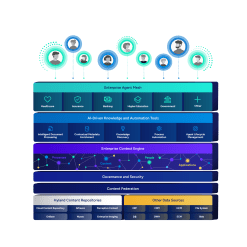Benefits
Drive more efficiency, create better outcomes and make more informed decisions with modern content management solutions.

Harness the power of a unified content, process and application intelligence platform to unlock the value of enterprise content.
Learn more
Automate your document-centric processes with AI-powered document capture, separation, classification, extraction and enrichment.
Learn about Hyland IDPIt's your unique digital evolution … but you don't have to face it alone. We understand the landscape of your industry and the unique needs of the people you serve.
 Overview of industries
Overview of industries
Countless teams and departments have transformed the way they work in accounting, HR, legal and more with Hyland solutions.
 Overview of departments
Overview of departments
We are committed to helping you maximize your technology investment so you can best serve your customers.
 Overview of services
Overview of services

Discover why Hyland is trusted by thousands of organizations worldwide.
Hear from our customers
Our exclusive partner programs combine our strengths with yours to create better experiences through content services.
Overview of partners
Find resources to power your organization's digital transformation.
Browse the resource center
Hyland connects your content and systems so you can forge stronger connections with the people who matter most.
Learn about HylandWith our modern, open and cloud-native platforms, you can build strong connections and keep evolving.
 Dig deeper
Dig deeper
Organize and optimize all content and assets across the entire organization.

Content and data are growing in volume, variety and velocity, but legacy systems weren’t designed to manage it in a way that meets the demands and requirements of modern organizations. Hyland simplifies how users interact with the information they need by making it easily findable and accessible while keeping it secure and compliant.
Drive more efficiency, create better outcomes and make more informed decisions with modern content management solutions.
Take advantage of modern data security protocols and controls to protect enterprise and customers data throughout its lifecycle.
Eliminate content silos with federated content management across multiple repositories and enterprise applications.
Speed up processes and decisions by intelligently and securely serving up relevant content to the users, processes and systems that need it.
Give customers, end users and administrators the benefit of modern, flexible and intuitive technology that helps get the job done, where and how they prefer.
Hyland’s content management features:
Support internal and remote users, as well as external stakeholders, with always-available access to the information they need.
Simplify content management and collaboration with features like version control, electronic signatures, annotations and audit trails.
Establish a single source of truth and eliminate content silos throughout the enterprise without complex and expensive legacy system migrations.
Search across all federated repositories to find the relevant information wherever it is stored.
Work digitally regardless of document format, and support high-resolution, rich media photography and videos, complex CAD drawings and more.
Enable users to easily, securely and quickly view content regardless of file size or format and without requiring native applications.
— Mauro Cacciafani, Architecture & Security Manager, Publiacqua S.p.A.

World networking leader runs faster and more efficiently with Hyland's Alfresco platform.

Facing challenges with disconnected and outdated legacy systems, ABN AMRO needed a modern way to manage its critical information. By implementing Hyland Nuxeo, the bank successfully broke down information silos and created a unified, intelligent approach to content management. This transformation not only enhanced operational efficiency but also positioned ABN AMRO to deliver superior value to its clients and stakeholders.

Financial cooperative implements a more robust ECM solution and increases efficiencies enterprisewide.


Meet industry-specific needs for managing content.
Manage your particular content
We have received your message and will be in contact shortly.
We have received your message and will be in contact shortly.